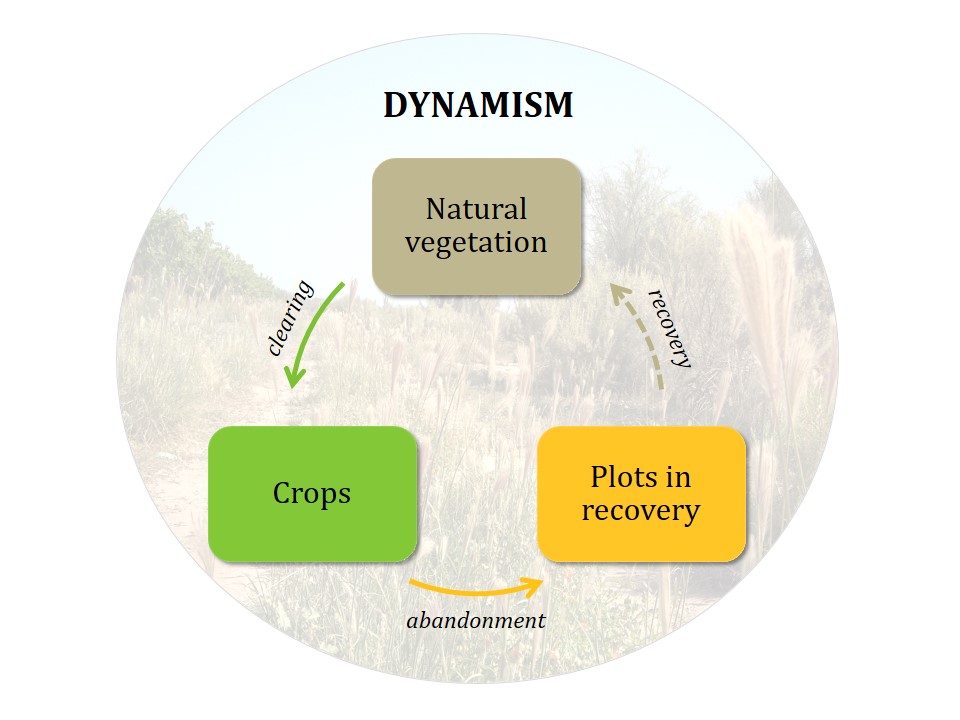Fragmented areas due to agricultural activity: native vegetation dynamics at crop interface (Montecaseros, Mendoza, Argentina)
DOI:
https://doi.org/10.48162/rev.39.108Palabras clave:
comunidades vegetales, cultivos abandonados, dinamismo, fragmentación de hábitat, degradación de suelosResumen
 Plant communities fragmented by agricultural activities were analyzed in a 250-ha area in eastern plains of Montecaseros, Gral. San Martín Department, Mendoza, Argentina. A phytosociological method assessed different sites along a gradient of human intervention, from natural environments with no evidence of altered native vegetation to maximum farming modification, also including cleared and abandoned fields. Soil analyses supplemented the characterization of six plant communities. A scrubland physiognomy dominates the area, with species of the genera Larrea, Atriplex and Lycium. Tillage and crop abandonment can alter natural factors involved in soil formation, causing deterioration and exerting selective pressure on species colonizing these degraded environments. Evaluating natural vegetation before land clearing for agriculture is essential to assess, through species that indicate environmental conditions, edaphic limitations hindering crop establishment and affecting productivity. The conservation of natural communities on private lands destined for agriculture is valued.
Plant communities fragmented by agricultural activities were analyzed in a 250-ha area in eastern plains of Montecaseros, Gral. San Martín Department, Mendoza, Argentina. A phytosociological method assessed different sites along a gradient of human intervention, from natural environments with no evidence of altered native vegetation to maximum farming modification, also including cleared and abandoned fields. Soil analyses supplemented the characterization of six plant communities. A scrubland physiognomy dominates the area, with species of the genera Larrea, Atriplex and Lycium. Tillage and crop abandonment can alter natural factors involved in soil formation, causing deterioration and exerting selective pressure on species colonizing these degraded environments. Evaluating natural vegetation before land clearing for agriculture is essential to assess, through species that indicate environmental conditions, edaphic limitations hindering crop establishment and affecting productivity. The conservation of natural communities on private lands destined for agriculture is valued.
Highlights:
- This study aimed to characterize plant communities in natural and intervened environments, in a representative area of the fragmentation processes caused by agriculture in the Monte Province (Mendoza, Argentina).
- Plant biodiversity plays a strategic role in ecosystemic provision of goods and services necessary to human health and well-being.
- Cultivable land is a vulnerable and scarce resource, particularly in drylands, where ecosystems have low capacity for natural regeneration. Tillage and crop abandonment can alter natural factors involved in soil formation, causing deterioration and exerting selective pressure on species colonizing these degraded environments.
- In agricultural land, clearing can give rise to a mosaic of landscapes: productive crops merge with abandoned crops and fragments of natural fields.
- Evaluating natural vegetation before land clearing for agriculture is essential to assess, through species that indicate environmental conditions, edaphic limitations hindering crop establishment and affecting productivity.
- Studies of vegetation dynamism in private lands contribute to plan and implement sustainable land management, tending to recover and conserve biodiversity in degraded soils, considering all associated ecosystem services.
Descargas

Descargas
Publicado
Cómo citar
Número
Sección
Licencia
Derechos de autor 2018 Revista de la Facultad de Ciencias Agrarias UNCuyo

Esta obra está bajo una licencia internacional Creative Commons Reconocimiento-NoComercial-CompartirIgual 3.0.
Aquellos autores/as que tengan publicaciones con esta revista, aceptan las Políticas Editoriales.










.jpg)




